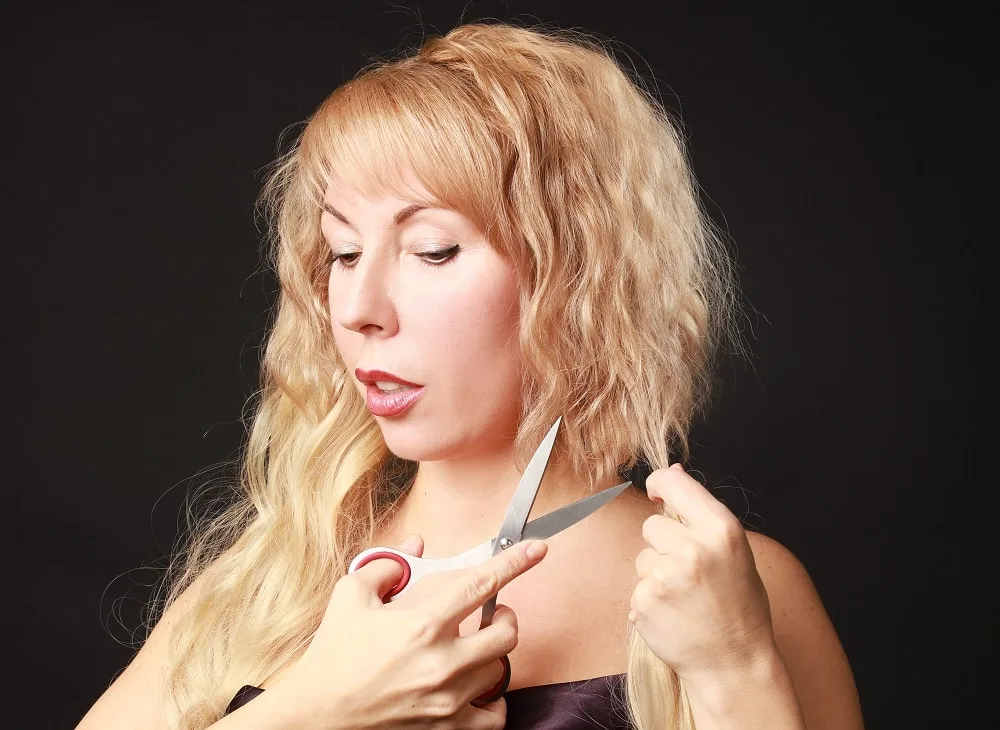A chemical haircut makes your hair look messy. The ends look split, and the overall appearance is dull.
You can protect yourself from a chemical cut by using soft-bristled brushes and only brushing your hair when it’s dry. Using microfiber towels also prevents your strands from splitting. If you already have a chemical cut, read on to learn how to care for your hair and bring it back to its healthy shine.
What Are Chemical Cuts?

A chemical haircut happens when you over-treat your hair and cause it to break off. If you color your hair too frequently or undergo straightening treatments, the chemicals used can weaken the bonds and damage your hair.
When you try to brush your hair, you might find that the texture is rubbery, with strands stretching away from your scalp as they tangle in the bristles.
Your hair might break off when you brush it or run your hands through it. While some breakage is normal, you want to keep an eye on it at this stage.
People who dye their hair too often are at risk of chemical cuts. If you’re going from one color to the other end of the spectrum, you’re over-processing your hair, which weakens it and can cause hair to break.
Signs of an Approaching Chemical Cut
 Save
SaveMany people can tell they’re getting close to a chemical haircut because they recently treated their hair and found that it’s not showing the intended results. Instead, they might see some of these common signs:
● Broken strands
● Rubbery texture
● Thinning hair
● Torched tips
● Uneven lengths
If you notice these signs, it’s time to be gentle. Read on to find out how you can avoid the dreaded chemical haircut.
How To Avoid a Chemical Haircut
It’s common to experience chemical damage when dyeing or bleaching your hair because the drastic process uses many chemicals. It’s best to use gentle dyes and lighteners when you color your hair.
Don’t leave the developer on longer than the instructions advise. You might think you’ll get a more vibrant color, but it’s only damaging your scalp. A wickness test, when you put the dye on the hair near your neck, will show you how it interacts with your hair.
You don’t need to dye the short hairs around your face as frequently as others. They’re new, fragile hairs, so you can comb them forward and only dye the rest of the hair on your head. Ideally, you only use hair dye every six to eight weeks. This period gives your hair time to get healthy after the chemical process changes its color.
How To Fix Your Hair After a Chemical Cut
People with a chemical cut can start repairing their hair with these steps.
1. Stop All Treatment
Stop coloring, straightening, and treating your hair with bleach to go blonde. You need to keep your hair as healthy as possible, which means you should avoid heat styling.
2. Get a Haircut
 Save
SaveCutting your hair when working toward a particular look is frustrating, but cutting off the broken hair will help you repair your scalp. Go to a salon so a professional can remove the damaged sections and give you a cute shag style.
3. Gently Shampoo Your Hair
If you’re the type who loves to lather their hair with shampoo, you’ll want to cool it down during your hair’s repair process. You don’t need to use shampoo too often at this point because you want to keep your natural oils.
4. Condition and Nourish Your Hair
Upgrade your hair care products to the nourishing type. You want to buy strengthening shampoos and deep conditioners that encourage new growth. Leave-in conditioners can also help repair the chemical damage from previous treatments. Hair masks and oil massages also help.
5. Protect Your Hair Against Damage
 Save
SaveContinue doing all you can to protect your hair against damage. Shampoo gently and brush in that same manner. Soft-bristle brushes cause less harm than plastic ones. Don’t brush your hair wet. Avoid tight ponytails and fancy hairstyles while you repair your hair.
Since you don’t want to use heat from a hair dryer, invest in microfiber towels for your hair. These towels absorb more moisture to dry your hair gently, while other towels split it and make it look frizzy.
In addition to new towels, get a new pillowcase. Silk pillowcases reduce friction, so your hair won’t break off when you toss and turn.
Final Thoughts
Knowing the causes and signs of a chemical cut helps you understand how to treat your hair. Space out your chemical treatments as much as you can to prevent a chemical cut from happening.
Using nourishing products and treating your hair well ensures you repair and restore it to its natural luster.
FAQs on Chemical Cut
You’ve learned what the dreaded chemical cut is, what to look for, and how to repair your hair. If you need more information, check out the answers to these frequently asked questions.
Yes, getting a haircut is ideal maintenance. It removes split ends and broken hair. It also keeps your hair from getting too heavy and breaking off near the scalp.
Yes, hair that broke off due to chemical damage can grow back. However, if you burn your hair follicles by leaving harsh chemicals on your scalp for too long, they’re unlikely to grow new hair. A chemical cut can eventually lead to alopecia.
If you follow the proper hair care steps and gently nourish your damaged hair, you can see a difference as soon as six months. Depending on the extent of the damage, it could take a year or more to fully recover your locks.
